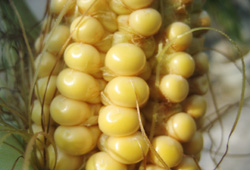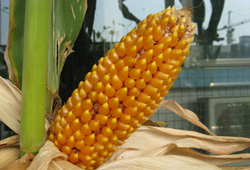|
 |
 |
|
flax-corn (COURTESY OF ZHU PEIKUN) |
wheat-corn (COURTESY OF ZHU PEIKUN) |
On January 1, the New Plant Variety Protection Office of China's Ministry of Agriculture issued "birth certificates" to two new plant species, Bioroad Pearl 18 and Bioroad Pearl 216, which were created by hybridizing the chromosomes of pea and corn. The achievements are just two among those Chinese scientists can lay claim to as the nation establishes itself as a pioneer in chromosome hybridization technology.
The family tree
In the past, claims of crossbreeding between two species from such distant plant families would have been met with ridicule. A widely accepted maxim is that distant hybridization will always cause sterility. However, Chinese scientist Zhu Peikun, founder and chief scientist of Shenzhen Bioroad Biotechnology Co. Ltd. in Shenzhen, south China's Guangdong Province, has proved this to be false.
At the end of 2014, experts from Shanghai-based Fudan University and Hong Kong University proved that pea and corn had indeed been successfully crossbred into a new crop variety after conducting an immunoelectrophoresis analysis of Bioroad's samples. That signified the official dawning of a new era in which man can modify any graminaceous crop.
Fluorescence imaging photos of in situ chromosome hybridization between pea and corn clearly showed that the chromosomes of the two crops have been brought together to produce a new chromosome type.
Zhu, the forerunner of plant chromosome hybridization theory, began his research in this field in 1982. In the beginning, he wanted to crossbreed cole and garlic, which are also distantly related. He hoped to protect cole from aphids by giving them the smell of garlic.
After graduating from the Department of Biology of Fudan University, he went to teach at his alma mater. Since 1986, he had conducted research in the University of Minnesota in the United States and the Hong Kong University of Science and Technology. He returned to China in 2001. In that year, he made a breakthrough in chromosome hybridization by crossbreeding higher plants of different species. In 2011, Shandong Science and Technology Publishing House published his book Chromosome Hybridization in Higher Plants, an academic insight into chromosome hybridization technology.
A biotech breakthrough
In the past, hybridization usually occurred between different varieties of the same species. Zhu's research focuses on introducing a chromosome from a plant species into the cells of another, distant species, in order to produce a new type of plant with a hybridized chromosome. Theoretically, with this technology, humans can crossbreed any two species of higher plant to produce a new plant variety.
Zhu said that by crossbreeding crops with plants that have a stronger tolerance for droughts or saline environments--such as cordgrass and camel thorn--we can create new crops that can be cultivated in saline or even slightly alkaline land. Crossbreeding high-nutrition crops with high-yield crops can produce high yielding and nutritious new crops, as was the case when flax and corn were hybridized.
So far, Zhu has created more than 100 new crops by combining pairs such as pea and corn, wheat and corn, sorghum and rice, corn and rice, as well as corn and wheat. By 2009, the Ministry of Agriculture had already issued certificates for new plant varieties for his rice-corn and wheat -corn splices.
Biochemical analysis of flax-corn grown in northwest China's Shaanxi Province showed that the content of its oleic acid, a common monounsaturated fat in the human diet, has increased by 26.81 percent, which is higher than that of ordinary corn, representing a significant improvement over corn's original nutritional value.
| 